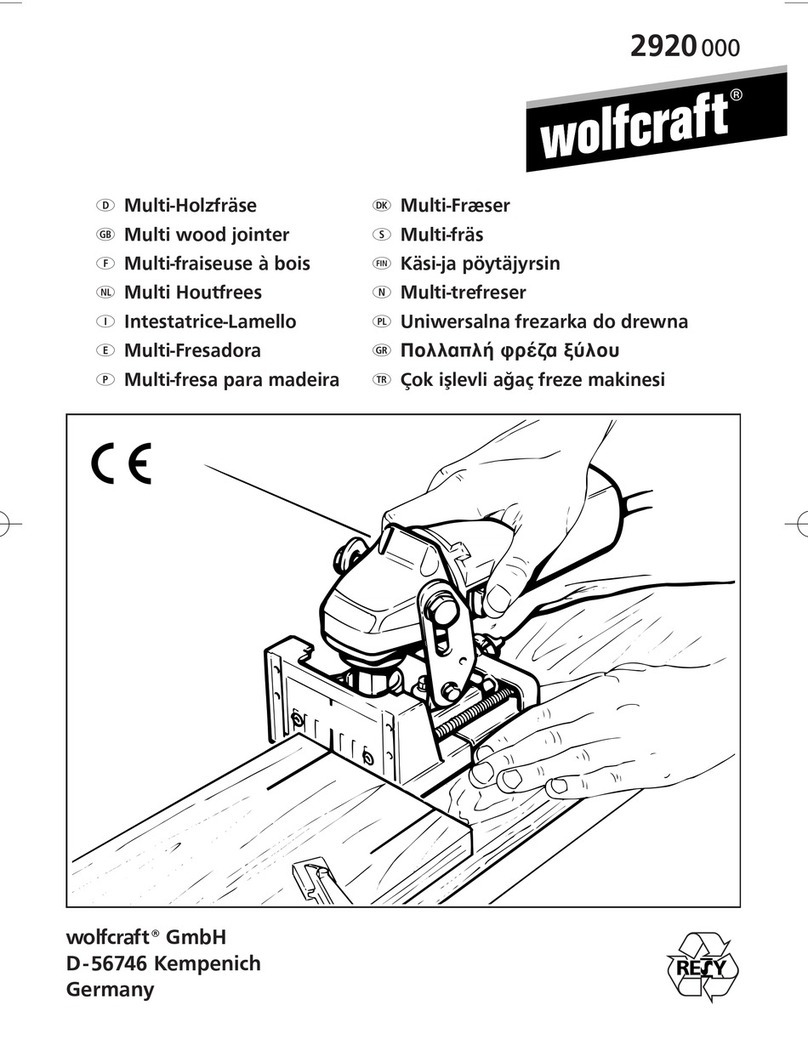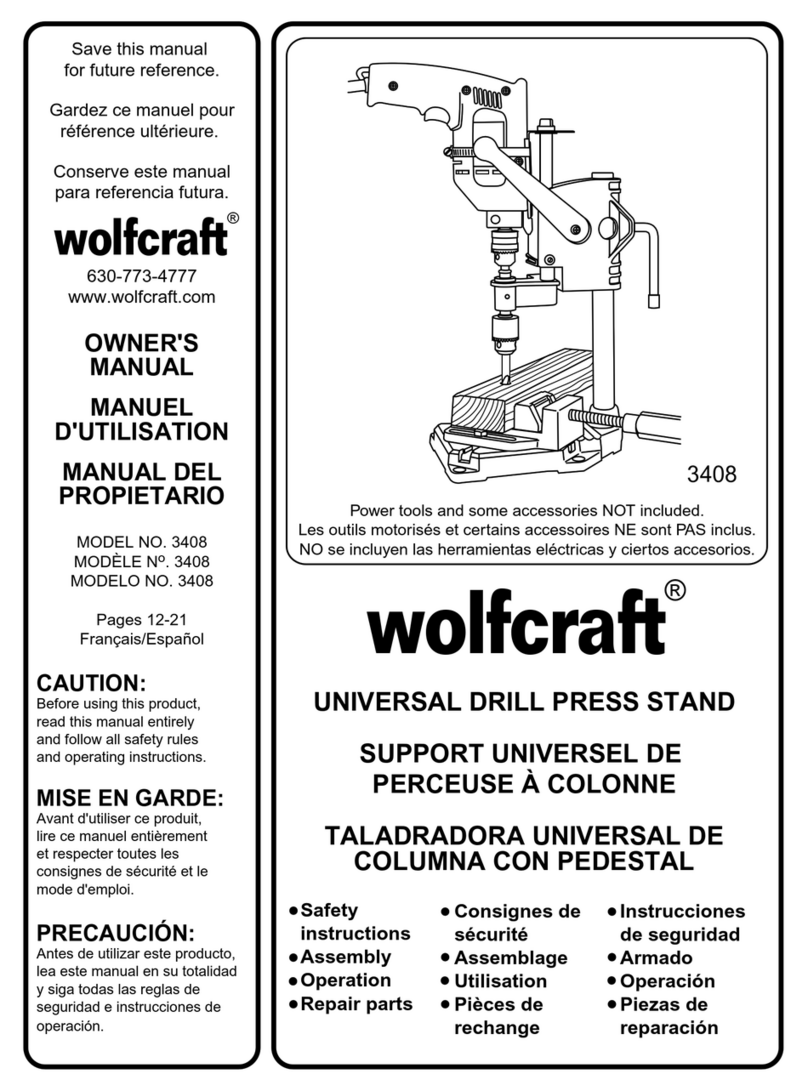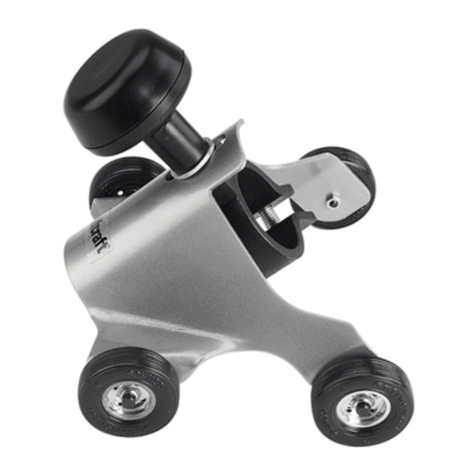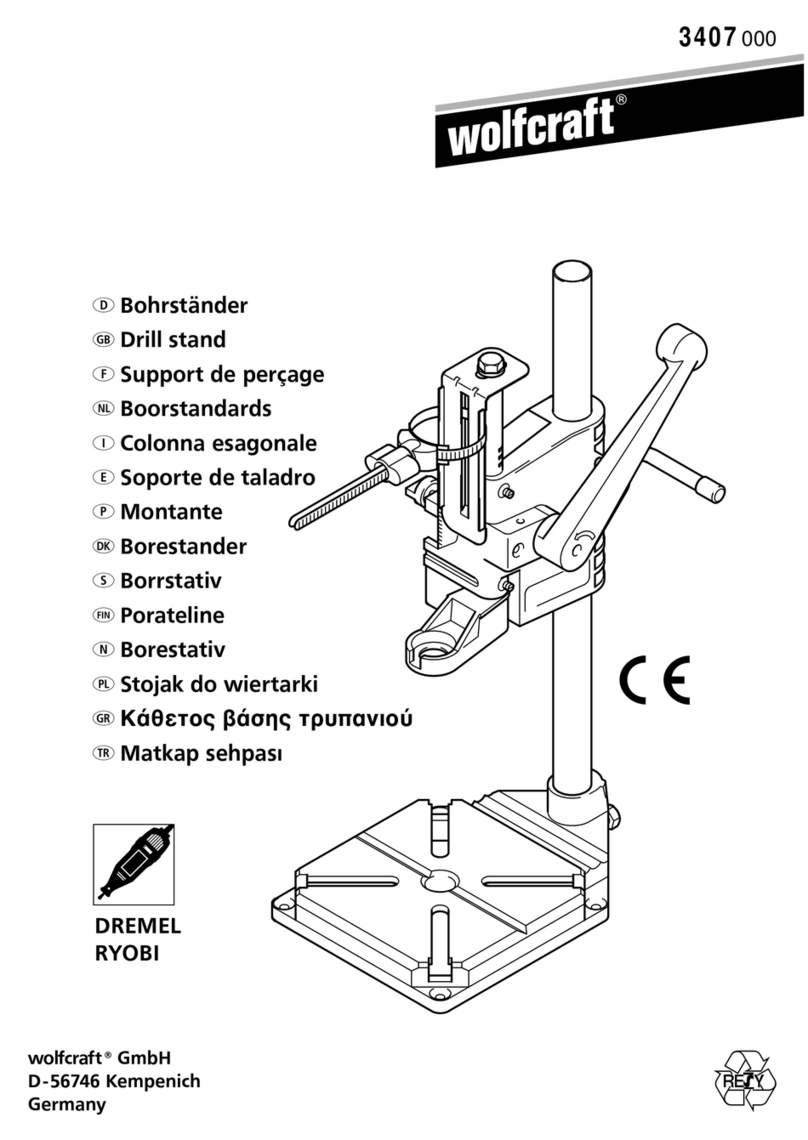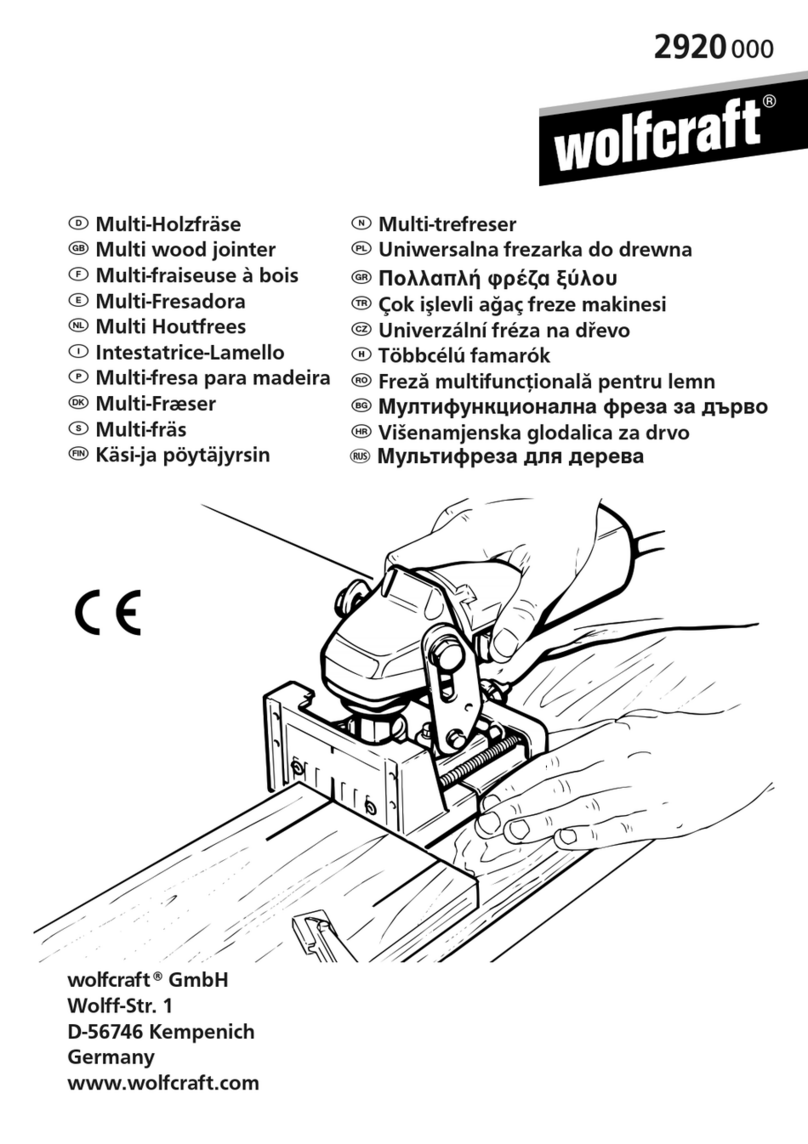
Allgemeine Sicherheitshinweise für Elektrowerkzeuge - Sicherheit von Perso-
nen
– Seien Sie aufmerksam, achten Sie darauf, was Sie tun, und gehen Sie mit Ver-
nunft an die Arbeit mit einem Elektrowerkzeug. Benutzen Sie kein Elektro-
werkzeug, wenn Sie müde sind oder unter dem Einfluss von Drogen, Alkohol
oder Medikamenten stehen. Ein Moment der Unachtsamkeit beim Gebrauch
des Elektrowerkzeugs kann zu ernsthaften Verletzungen führen.
– Tragen Sie persönliche Schutzausrüstung und immer eine Schutzbrille. Das
Tragen persönlicher Schutzausrüstung, wie Schutzmaske, rutschfeste Sicher-
heitsschuhe, Schutzhelm, Gehörschutz oder enganliegender Schutzkleidung,
je nach Art und Einsatz des Elektrowerkzeugs, verringert das Risiko von Verlet-
zungen.
– Vermeiden Sie eine unbeabsichtigte Inbetriebnahme. Vergewissern Sie sich,
dass das Elektrowerkzeug ausgeschaltet ist, bevor Sie es an die Stromversor-
gung und / oder den Akku anschließen, es aufnehmen oder tragen. Wenn Sie
beim Tragen des Elektrowerkzeugs den Finger am Schalter haben oder das
Gerät eingeschaltet an die Stromversorgung anschließen, kann dies zu Unfäl-
len führen.
– Entfernen Sie Einstellwerkzeuge oder Schraubenschlüssel, bevor Sie das Elek-
trowerkzeug einschalten. Ein Werkzeug oder Schlüssel, der sich in einem dre-
henden Geräteteil befindet, kann zu Verletzungen führen.
– Tragen Sie geeignete Kleidung. Tragen Sie keine weite Kleidung oder
Schmuck. Halten Sie Haare, Kleidung und Handschuhe fern von sich bewe-
genden Teilen. Lockere Kleidung, Schmuck oder lange Haare können von sich
bewegenden Teilen erfasst werden.
– Wenn Staubabsaug- und -auffangeinrichtungen montiert werden können, ver-
gewissern Sie sich, dass diese angeschlossen sind und richtig verwendet wer-
den. Die Verwendung einer Staubabsaugung kann Gefährdungen durch Staub
verringern.
Allgemeine Sicherheitshinweise für Elektrowerkzeuge - Verwendung und Be-
handlung des Elektrowerkzeugs
– Überlasten Sie das Gerät nicht. Verwenden Sie für Ihre Arbeit das dafür be-
stimmte Elektrowerkzeug. Mit dem passenden Elektrowerkzeug arbeiten Sie
besser und sicherer im angegebenen Leistungsbereich.
– Benutzen Sie kein Elektrowerkzeug, dessen Schalter defekt ist. Ein Elektro-
werkzeug, das sich nicht mehr einoder ausschalten lässt, ist gefährlich und
muss repariert werden.
– Ziehen Sie den Netzstecker aus der Netzsteckdose und / oder entfernen Sie
den Akku, bevor Sie Geräteeinstellungen vornehmen, Zubehörteile wechseln
oder das Gerät weglegen. Diese Vorsichtsmaßnahme verhindert den unbeab-
sichtigten Start des Elektrowerkzeugs.
– Bewahren Sie unbenutzte Elektrowerkzeuge außerhalb der Reichweite von
Kindern auf. Lassen Sie Personen das Gerät nicht benutzen, die mit diesem
nicht vertraut sind oder diese Anweisungen nicht gelesen haben. Elektrowerk-
zeuge sind gefährlich, wenn sie von unerfahrenen Personen benutzt werden.
– Pflegen Sie Elektrowerkzeuge mit Sorgfalt. Kontrollieren Sie, ob bewegliche
Teile einwandfrei funktionieren und nicht klemmen, ob Teile gebrochen oder
so beschädigt sind, dass die Funktion des Elektrowerkzeugs beeinträchtigt ist.
Lassen Sie beschädigte Teile vor dem Einsatz des Gerätes reparieren. Viele Un-
fälle haben ihre Ursache in schlecht gewarteten Elektrowerkzeugen.
– Halten Sie Schneidwerkzeuge scharf und sauber. Sorgfältig gepflegte Schneid-
werkzeuge mit scharfen Schneidkanten verklemmen sich weniger und sind
leichter zu führen.
– Verwenden Sie Elektrowerkzeug, Zubehör, Einsatzwerkzeuge usw. entspre-
chend diesen Anweisungen. Berücksichtigen Sie dabei die Arbeitsbedingun-
gen und die auszuführende Tätigkeit. Der Gebrauch von Elektrowerkzeugen
für andere als die vorgesehenen Anwendungen kann zu gefährlichen Situatio-
nen führen.
Allgemeine Sicherheitshinweise für Elektrowerkzeuge - Service
– Lassen Sie Ihr Elektrowerkzeug nur von qualifiziertem Fachpersonal und nur
mit Original-Ersatzteilen reparieren. Damit wird sichergestellt, dass die Sicher-
heit des Elektrowerkzeugs erhalten bleibt.
SICHERHEITSHINWEISE FÜR WINKELSCHLEIFER
–Beachten Sie neben diesen maschinenspezifischen Sicherheitshinweisen
unbedingt die Sicherheitshinweise des verwendeten Winkelschleifers.
– Seien Sie immer darauf vorbereitet, dass beim Schneiden das Werkstück uner-
wartet und plötzlich außer Kontrolle geraten und zurückschlagen kann.
– Verwenden Sie nur Diamanttrennscheiben nach DINEN-13236.
– Halten Sie während des Schneidens die Hände fern vom Schleifwerkzeug.
– Stellen Sie sicher, dass die Absaughaube ordnungsgemäß an den Winkel-
schleifer montiert ist und alle Schrauben/Griffschrauben angezogen sind.
– Führen Sie keine Veränderungen oder Modifikationen an diesem Produkt
durch.
– Verwenden Sie kein Zubehör, das vom Hersteller nicht speziell für dieses Elek-
trowerkzeug vorgesehen und empfohlen wurde. Nur weil Sie das Zubehör an
Ihrem Elektrowerkzeug befestigen können, garantiert das keine sichere Ver-
wendung.
– Die zulässige Drehzahl des Einsatzwerkzeugs muss mindestens so hoch sein
wie die auf dem Elektrowerkzeug angegebene Höchstdrehzahl. Zubehör, das
sich schneller als zulässig dreht, kann zerbrechen und umherfliegen.
– Außendurchmesser und Dicke des Einsatzwerkzeugs müssen den Maßanga-
ben Ihres Elektrowerkzeugs entsprechen. Falsch bemessene Einsatzwerkzeuge
können nicht ausreichend abgeschirmt oder kontrolliert werden.
– Verwenden Sie keine beschädigten Einsatzwerkzeuge. Kontrollieren Sie vor je-
der Verwendung Einsatzwerkzeuge wie Schleifscheiben auf Absplitterungen
und Risse, Schleifteller auf Risse, Verschleiß oder starke Abnutzung, Draht-
bürsten auf lose oder gebrochene Drähte. Wenn das Elektrowerkzeug oder
das Einsatzwerkzeug herunterfällt, überprüfen Sie, ob es beschädigt ist, oder
verwenden Sie ein unbeschädigtes Einsatzwerkzeug. Wenn Sie das Einsatz-
werkzeug kontrolliert und eingesetzt haben, halten Sie und in der Nähe be-
findliche Personen sich außerhalb der Ebene des rotierenden Einsatzwerk-
zeugs auf und lassen Sie das Gerät 1 Minute lang mit Höchstdrehzahl laufen.
Beschädigte Einsatzwerkzeuge brechen meist in dieser Testzeit.
– Tragen Sie persönliche Schutzausrüstung. Verwenden Sie je nach Anwendung
Vollgesichtsschutz, Augenschutz oder Schutzbrille. Soweit angemessen, tra-
gen Sie Staubmaske, Gehörschutz, Schutzhandschuhe oder Spezialschürze,
die kleine Schleif- und Materialpartikel von Ihnen fernhalten. Die Augen sol-
len vor herumfliegenden Fremdkörpern geschützt werden, die bei verschiede-
nen Anwendungen entstehen. Staub- oder Atemschutzmaske müssen den bei
der Anwendung entstehenden Staub filtern. Wenn Sie lange lautem Lärm aus-
gesetzt sind, können Sie einen Hörverlust erleiden. • Achten Sie
– Achten Sie bei anderen Personen auf sicheren Abstand zu Ihrem Arbeitsbe-
reich. Jeder, der den Arbeitsbereich betritt, muss persönliche Schutzausrüs-
tung tragen. Bruchstücke des Werkstücks oder gebrochener Einsatzwerkzeuge
können wegfliegen und Verletzungen auch außerhalb des direkten Arbeitsbe-
reichs verursachen.
– Halten Sie das Elektrowerkzeug nur an den isolierten Griffflächen, wenn Sie
Arbeiten ausführen, bei denen das Einsatzwerkzeug verborgene Stromleitun-
gen oder das eigene Netzkabel treffen kann. Der Kontakt mit einer span-
nungsführenden Leitung kann auch metallene Geräteteile unter Spannung
setzen und zu einem elektrischen Schlag führen.
– Halten Sie das Netzkabel von sich drehenden Einsatzwerkzeugen fern. Wenn
Sie die Kontrolle über das Gerät verlieren, kann das Netzkabel durchtrennt
oder erfasst werden und Ihre Hand oder Ihr Arm in das sich drehende Einsatz-
werkzeug geraten.
– Legen Sie das Elektrowerkzeug niemals ab, bevor das Einsatzwerkzeug völlig
zum Stillstand gekommen ist. Das sich drehende Einsatzwerkzeug kann in
Kontakt mit der Ablagefläche geraten, wodurch Sie die Kontrolle über das
Elektrowerkzeug verlieren können.
– Lassen Sie das Elektrowerkzeug nicht laufen, während Sie es tragen. Ihre Klei-
dung kann durch zufälligen Kontakt mit dem sich drehenden Einsatzwerkzeug
erfasst werden und das Einsatzwerkzeug sich in Ihren Körper bohren.
– Reinigen Sie regelmäßig die Lüftungsschlitze Ihres Elektrowerkzeugs. Das Mo-
torgebläse zieht Staub in das Gehäuse und eine starke Ansammlung von Me-
tallstaub kann elektrische Gefahren verursachen.
– Verwenden Sie das Elektrowerkzeug nicht in der Nähe brennbarer Materiali-
en. Funken können diese Materialien entzünden.
– Verwenden Sie keine Einsatzwerkzeuge, die flüssige Kühlmittel erfordern. Die
Verwendung von Wasser oder anderen flüssigen Kühlmitteln kann zu einem
elektrischen Schlag führen.
4

